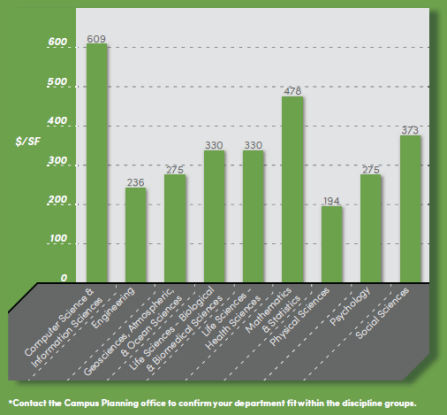Building partnerships through collaboration.
Research Utilization Standards
Review the guidelines that articulate the size, utilization, and assignments for various types of research space at UB.
ON THIS PAGE:
Guidelines
The following guidelines articulate the sizes, utilization, and assignments for various types of research space at UB:
- Faculty may be assigned space which is appropriate to their research activities. In general, assignments will not be made based on seniority or faculty type. Some research predicates a particular space type, however when that is not the case, the research activity will be assessed along with space availability.
- The Campus Planning Office will work with departments to regularly review their space inventory to ensure appropriate utilization, to update rosters, and to make any space reallocations required.
- Research space is defined as a space housing faculty, staff or students working within specialized areas at the direction of a Principal Investigator (PI). Research space comes in a variety of sizes and types ranging from observation rooms, specialty equipment spaces, and wet lab environments.
Goal
The goal of the research space policy is to develop a reasonable benchmark using dollars (total expenditures) per square foot.
Assumptions
- Focuses on funded research activities that rely only on specialized (laboratory) spaces.
- Research activities in the context of fields such as the Liberal Arts are satisfied by office, library and similar spaces. These space types are quantified by other utilization metrics.
- Data sources and reporting are structured to create a repeatable comparison between UB with peer institutions.
- The NSF HERD survey defines the discipline groups into which all UB units using specialized research space are organized.
- Research space must be linked to PI and funding.
- Research space needs vary by discipline group.
- Expenditure levels are a reasonable proxy for active research populations.
Known Limitations
- Since some expenditure dollars are only linked to the department level and not an individual PI, an individual PI activity level may not be fully represented.
- There is a notion that PIs use their lab space for advising students, doing unfunded research, or education. This will be addressed on an individual PI basis. There are two possible ways to address this:
- The policy could state that specialized research spaces should only be used for funded research activities. Non-funded activities should be housed elsewhere and the university will best attempt to accommodate those needs.
- Modify the $/SF expectation to accommodate this expectation that faculty are not spending 100% of their lab time pursuing their research.
Target Dollars Per Square Foot by Discipline Group
Target $/SF by Discipline Group Based on Peer Analysis
Contact an Expert

Kelly M. Hayes Mcalonie FAIA, LEED AP
Director
Campus Planning
